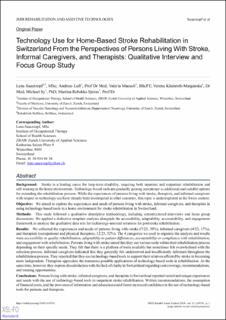Bitte benutzen Sie diese Kennung, um auf die Ressource zu verweisen:
https://doi.org/10.21256/zhaw-31241| Publikationstyp: | Beitrag in wissenschaftlicher Zeitschrift |
| Art der Begutachtung: | Peer review (Publikation) |
| Titel: | Technology use for home-based stroke rehabilitation in Switzerland from the perspectives of persons living with stroke, informal caregivers, and therapists : qualitative interview and focus group study |
| Autor/-in: | Sauerzopf, Lena Luft, Andreas Maeusli, Valeria Klamroth-Marganska, Verena Sy, Michael Spiess, Martina |
| et. al: | No |
| DOI: | 10.2196/59781 10.21256/zhaw-31241 |
| Erschienen in: | JMIR Rehabilitation and Assistive Technologies |
| Band(Heft): | 2024 |
| Heft: | 11 |
| Seite(n): | e59781 |
| Erscheinungsdatum: | 18-Jul-2024 |
| Verlag / Hrsg. Institution: | JMIR Publications |
| ISSN: | 2369-2529 |
| Sprache: | Englisch |
| Schlagwörter: | App; Home-based therapy; Mobile phone; Cccupational therapy; Outpatient rehabilitation; Physiotherapy; Stroke; Technology-based tool |
| Fachgebiet (DDC): | 615.8515: Ergotherapie 616.8: Neurologie und Krankheiten des Nervensystems |
| Zusammenfassung: | Background: Stroke is a leading cause for long-term disability, requiring both inpatient and outpatient rehabilitation and self-training in the home environment. Technology-based tools are gradually gaining acceptance as additional and suitable options for extending the rehabilitation process. While the experiences of persons living with stroke, therapists, and informal caregivers with respect to technology use have already been investigated in other countries, this topic is underexplored in the Swiss context. Objective: We aimed to explore the experiences and needs of persons living with stroke, informal caregivers, and therapists in using technology-based tools in a home environment for stroke rehabilitation in Switzerland. Methods: This study followed a qualitative descriptive methodology, including semistructured interviews and focus group discussions. We applied a deductive template analysis alongside the accessibility, adaptability, accountability, and engagement framework to analyze the qualitative data sets for technology-assisted solutions for poststroke rehabilitation. Results: We collected the experiences and needs of persons living with stroke (7/23, 30%), informal caregivers (4/23, 17%), and therapists (occupational and physical therapists; 12/23, 52%). The 4 categories we used to organize the analysis and results were accessibility to quality rehabilitation, adaptability to patient differences, accountability or compliance with rehabilitation, and engagement with rehabilitation. Persons living with stroke stated that they use various tools within their rehabilitation process depending on their specific needs. They felt that there is a plethora of tools available but sometimes felt overwhelmed with the selection process. Informal caregivers indicated that they generally felt underserved and insufficiently informed throughout the rehabilitation process. They reported that they use technology-based tools to support their relatives affected by stroke in becoming more independent. Therapists appreciate the numerous possible applications of technology-based tools in rehabilitation. At the same time, however, they express dissatisfaction with the lack of clarity in Switzerland regarding cost coverage, recommendations, and training opportunities. Conclusions: Persons living with stroke, informal caregivers, and therapists in Switzerland reported varied and unique experiences and needs with the use of technology-based tools in outpatient stroke rehabilitation. Written recommendations, the assumption of financial costs, and the provision of information and education could foster increased confidence in the use of technology-based tools for patients and therapists. |
| URI: | https://digitalcollection.zhaw.ch/handle/11475/31241 |
| Volltext Version: | Publizierte Version |
| Lizenz (gemäss Verlagsvertrag): | CC BY 4.0: Namensnennung 4.0 International |
| Departement: | Gesundheit |
| Organisationseinheit: | Institut für Ergotherapie (IER) |
| Publiziert im Rahmen des ZHAW-Projekts: | Technologien für die Therapie auf Distanz nach Schlaganfall |
| Enthalten in den Sammlungen: | Publikationen Gesundheit |
Dateien zu dieser Ressource:
| Datei | Beschreibung | Größe | Format | |
|---|---|---|---|---|
| 2024_Sauerzopf-etal_Technology-use-home-based-stroke-rehabilitation_JMIR.pdf | 731.17 kB | Adobe PDF |  Öffnen/Anzeigen |
Zur Langanzeige
Sauerzopf, L., Luft, A., Maeusli, V., Klamroth-Marganska, V., Sy, M., & Spiess, M. (2024). Technology use for home-based stroke rehabilitation in Switzerland from the perspectives of persons living with stroke, informal caregivers, and therapists : qualitative interview and focus group study. JMIR Rehabilitation and Assistive Technologies, 2024(11), e59781. https://doi.org/10.2196/59781
Sauerzopf, L. et al. (2024) ‘Technology use for home-based stroke rehabilitation in Switzerland from the perspectives of persons living with stroke, informal caregivers, and therapists : qualitative interview and focus group study’, JMIR Rehabilitation and Assistive Technologies, 2024(11), p. e59781. Available at: https://doi.org/10.2196/59781.
L. Sauerzopf, A. Luft, V. Maeusli, V. Klamroth-Marganska, M. Sy, and M. Spiess, “Technology use for home-based stroke rehabilitation in Switzerland from the perspectives of persons living with stroke, informal caregivers, and therapists : qualitative interview and focus group study,” JMIR Rehabilitation and Assistive Technologies, vol. 2024, no. 11, p. e59781, Jul. 2024, doi: 10.2196/59781.
SAUERZOPF, Lena, Andreas LUFT, Valeria MAEUSLI, Verena KLAMROTH-MARGANSKA, Michael SY und Martina SPIESS, 2024. Technology use for home-based stroke rehabilitation in Switzerland from the perspectives of persons living with stroke, informal caregivers, and therapists : qualitative interview and focus group study. JMIR Rehabilitation and Assistive Technologies. 18 Juli 2024. Bd. 2024, Nr. 11, S. e59781. DOI 10.2196/59781
Sauerzopf, Lena, Andreas Luft, Valeria Maeusli, Verena Klamroth-Marganska, Michael Sy, and Martina Spiess. 2024. “Technology Use for Home-Based Stroke Rehabilitation in Switzerland from the Perspectives of Persons Living with Stroke, Informal Caregivers, and Therapists : Qualitative Interview and Focus Group Study.” JMIR Rehabilitation and Assistive Technologies 2024 (11): e59781. https://doi.org/10.2196/59781.
Sauerzopf, Lena, et al. “Technology Use for Home-Based Stroke Rehabilitation in Switzerland from the Perspectives of Persons Living with Stroke, Informal Caregivers, and Therapists : Qualitative Interview and Focus Group Study.” JMIR Rehabilitation and Assistive Technologies, vol. 2024, no. 11, July 2024, p. e59781, https://doi.org/10.2196/59781.
Alle Ressourcen in diesem Repository sind urheberrechtlich geschützt, soweit nicht anderweitig angezeigt.